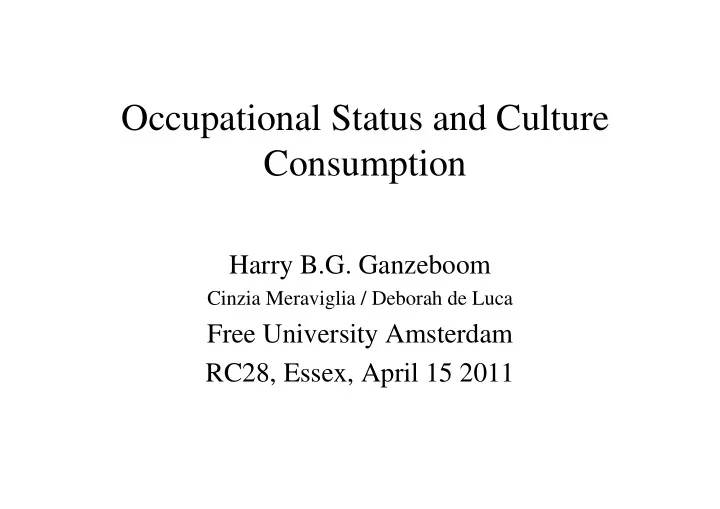

Occupational Status and Culture Consumption Harry B.G. Ganzeboom Cinzia Meraviglia / Deborah de Luca Free University Amsterdam RC28, Essex, April 15 2011
The Chan-Goldthorpe thesis • A (high-brow) culture life-style is the expression pur sang of social status (= ‘social honour’, ‘prestige’, ‘relational status’). • Such at the expense of social (=socio- economic) class measure of occupational status. Status and Cultural Consumption 2
The Chan-Goldthorpe book • Six countries: UK, USA, France, Netherlands, Chile, Hungary. • Each country had developed its own relational status scale using friendship or marital association data. N(occupations) around 30. • The empirical analyses show these relational status measures to be superior to social class measures in predicting cultural consumption. Status and Cultural Consumption 3
Earlier literature: the Cambridge scales and prestige scales • The Chan-Goldthorpe relational scales are conceptually and in construction procedure equivalent to ‘relational scales’ of occupational status as produced by the Camsis project. • Conceptually, there is also strong overlap with subjective (prestige) measures of occupational status, as produced for international use by Treiman (1977). Status and Cultural Consumption 4
Chan (54) on CAMSIS • “… our status scale and CAMSIS are constructed in very similar ways... What sets us apart, is a rather fundamental conceptual difference.” [Camsis group] maintains that “‘research has tended to eliminate the distinction between class and status’ … In stead of rejecting the class-status distinction by fiat , we investigate empirically “whether as status order is still identifiable in contemporary societies and whether class and status have differing explanatory power in different areas of social life..”. Status and Cultural Consumption 5
Bourdieu • In contrast to Chan & Goldthorpe, Bourdieu (1984) clearly identifies the occupational classes that are especially prone to a cultural lifestyle: professionals, educated elite, arts producers. • Earlier work by Ganzeboom et al. / Kraaijkamp & Kalmijn has confirmed the particular positions of cultural status of occupations. • Kraaijkamp & Kalmijn have also suggested that cultural status of occupations can largely be equalized with educational requirement of occupations, one of the two components of SEI scales (cfr Warren and Hauser) Status and Cultural Consumption 6
Goals of the present paper • Introduce the international CAMSIS scale ICAM. • Use this to test the Chan-Goldthorpe thesis in a large-scale comparative perspective. • Compare systematically to other measures of occupational status: – SIOPS prestige – ISEI socio-economic status – Cultural status / occupational education Status and Cultural Consumption 7
Expectations • Occupational effects on culture consumption are minor • And strongly confounded by education (when appropriately measured and modeled) • And are restricted to the cultural status of occupations. Status and Cultural Consumption 8
ICAM: International CAMSIS • ICAM was recently developed for ISCO-88 by Meraviglia, De Luca & Ganzeboom (2010). • We took > 110.000 cases from ISSP 2002-2007 (42 countries) with detailed (ISCO-88) occupation codes for respondents and spouses. • Preliminary validations showed ICAM to be strongly related to ISEI, with almost equal measurement properties in modeling status attainment. Status and Cultural Consumption 9
Validation model (ESS data, N=51000) ISEI ICAM .94 .95 SOCC .56 .17 SEDUC .07 .59 .15 HHINC .07 REDUC .56 .17 ROCC .94 .95 ISEI ICAM 10
ISSP 2007: Leisure Module • The ISSP 2007 (Leisure and Sports) asks for participation in the following cultural activities: – Going to the movies – Read books – Attend cultural events – Spend time on the internet. • These indicators form a consistent scale with reliabilities around 0.629 (range 0.50..0.75). Status and Cultural Consumption 11
Status and Cultural Consumption 12
Confounders • Female: women (1) are more culturally active than men (0) and have different levels of education and occupation. • Age (restricted 25-64): Older respondents are generally less active. • Education (highest degree, rank-ordered): is generally the strongest predictor of cultural consumption. We also use the duration measure to correct for measurement error. Status and Cultural Consumption 13
Occupational status measures • ICAM: Relational status of occupation, derived from occupational homogamy relations. • SIOPS: Prestige of occupations, obtained from popular evaluations. • ISEI: Socio-economic status of occupation (averaging occupational earnings and educational requirements). • EDUREQ: occupations scaled by educational requirements (component of ISEI). Status and Cultural Consumption 14
CORRELATIONS CULPART AGE FEMALE EDUCTP EDDUR ICAM ISEI TREI EDUREQ CULPART 1.000 -.216 .061 .497 .476 .441 .408 .379 .421 AGE -.216 1.000 -.019 -.237 -.241 -.075 -.070 -.036 -.067 FEMALE .061 -.019 1.000 .009 .001 .116 .017 -.022 .093 EDUCTP .497 -.237 .009 1.000 .883 .611 .573 .557 .609 EDDUR .476 -.241 .001 .883 1.000 .575 .543 .528 .574 ICAM .441 -.075 .116 .611 .575 1.000 .896 .868 .913 ISEI .408 -.070 .017 .573 .543 .896 1.000 .880 .876 TREI .379 -.036 -.022 .557 .528 .868 .880 1.000 .846 EDUREQ .421 -.067 .093 .609 .574 .913 .876 .846 1.000 Status and Cultural Consumption 15
OLS models for effects of occupational status measures on culture consumption (completely standardized coefficients, ISSP 2007, N=30829, age 25-64). AGE -0.105 -0.121 -0.120 -0.117 -0.121 -0.119 -0.120 FEMALE 0.064 0.071 0.042 0.065 0.047 0.044 0.045 EDUC 0.467 0.368 0.326 0.351 0.324 0.339 0.320 ICAM 0.240 0.190 0.197 SIOPS 0.172 -0.014 ISEI 0.198 0.043 EDUREQ 0.203 0.035 Status and Cultural Consumption 16
Error corrected model Status and Cultural Consumption 17
Comparing indicators • ICAM clearly superior to SIOPS! • ICAM clearly superior to ISEI!! • ICAM even superior to EDUREQ!!! • ICAM’s effects – substantial (0.19) – mediates effect of education (1/3) – (is hardly mediated by household income). Status and Cultural Consumption 18
Comparing countries • ICAM is superior to ISEI in 25/35 countries. Status and Cultural Consumption 19
Conclusions • Chan & Goldthorpe are right: – Relational status of occupations has a considerable effect on culture consumption, – This is not (entirely) confounded by education, – And is unique to relational status (compared to all other measures of occupational status). • But / and: – Use ICAM for all your future culture consumption research. Status and Cultural Consumption 20
Recommend
More recommend